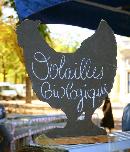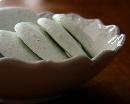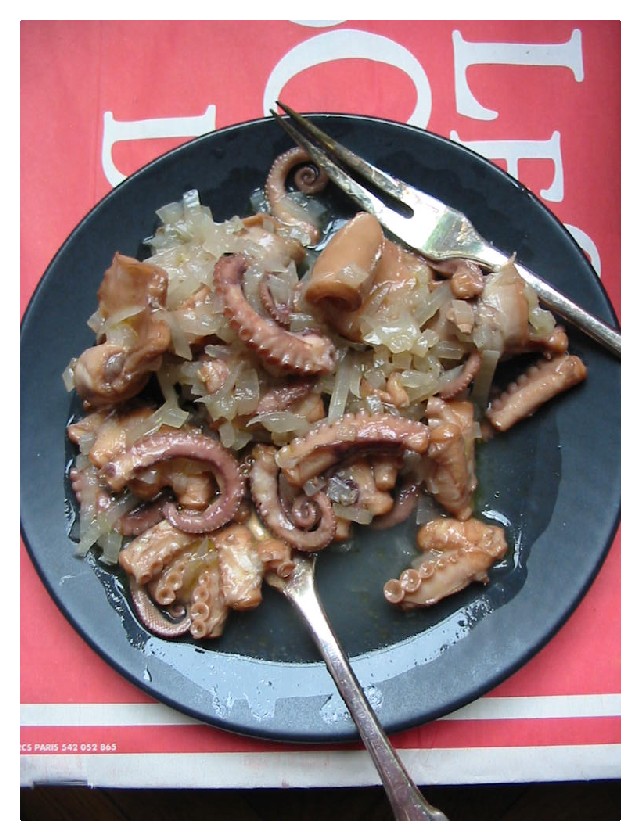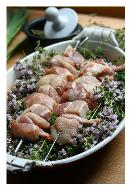Tuesday, October 31, 2006
Sunday, October 29, 2006
Sunday's Velouté Fumé d'Automne

This morning the shades were closed and I was dreaming strange dreams. After some tossing and turning, I got out of bed with a start. I thought it was Monday. I had agreed to meet a friend, and we hadn't exchanged rendez-vous details, so I started looking for her phone number. Loic had the coffee going, and he asked me if I knew what time it was, because today the clocks got turned back.
I stood there squinting in the uncommonly bright salon, ready for breakfast. Since it was actually an hour earlier than I thought it was, I wondered if it was too early to call my friend. It's amazing how much the light differs from one hour in the morning to the next. At the breakfast table, Loic seemed to be taking his time and yawned in a relaxed kind of way, uncommon for a Monday morning. He told me we were getting low on fruit: "Do you want to go to the market this morning?" It suddenly dawned on me that I had just gained an hour and a day. What a great way to begin a Sunday.
We indeed went for a bike ride and talked to the neighbors on the way back in. It looks as if the pretty little ladies' place where I used to have a cup of tea and a boiled egg from the bowl on the bar from time to time has been sold and the new owners have painted the entire place matte black. Oh well.
At the market we got salad greens, a wedge of pumpkin, pears and apples, olives, and fennel seeds. We completely replenished the cheese plate with Brie, Reblochon, Comte, a sechon from a local farmer, and Rocamador, which I plan to cook with. We purchased Diots de Savoie from two different vendors to compare them, sheep merguez, and thick slice of lightly smoked pork poitrine from my friend who grows the black free range pigs in the Bugey.
Today's soup was a recipe I have had in my kitchen notebook for the past couple of years. About 4 years ago, Hélène Darroze prepared a soup on Joel Robuchon's cooking show in which she simmered pureed chunks of smoked bacon along with beans to a smooth velouté. She did not mention where the recipe came from, but a couple of years after that I saw a collection of Fernand Point's cooking notes. One of the 9 soups in the collection is an excrutiatingly simple 35 word recipe for a velouté of smoked bacon and feves. It gives the soup a light smoky taste which is just the thing on autumn days. My soup evolved as I experimented with various pureed soups, a kind of soup I love to serve when the weather begins to cool down.
Velouté Fumé d'Automne

1T. butter
1 shallot
1 onion
2-3 potatoes
500g. or about a pound of pumpkin or autumn squash
1 carrot
2 leaves of dried sage
2 French bay leaves
3 sprigs of parsley
250 grams or 1/2 pound lightly smoked pork poitrine (bacon)
3 cups mixed poultry stock
salt and pepper
leftoever duck neck, sliced thin
seasonings: juniper berries, spice mix maison, szchwan pepper corns, etc.
salt and pepper
optional butter, creme fraiche, creme liquide, and or egg yolks.
lemon juice for brightening
Note on the seasonings:
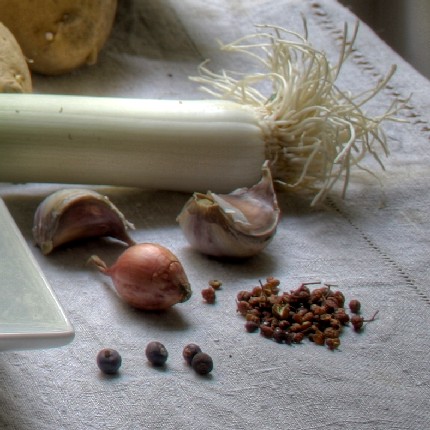 Since this veloute can take on many personalities depending on what meats and leftovers you have on hand for the garnish, keep an open mind about the seasonings. Today I ended up not using the leek or the garlic. I had initially considered them, but changed my mind. I was wavering between two ways to garnish it and decided to use the secret stash of duck necks, so I left the heavy seasonings out. I did decide to dust the soup with two juniper berries and szechuan peppercorns, which I do not regret at all.
Since this veloute can take on many personalities depending on what meats and leftovers you have on hand for the garnish, keep an open mind about the seasonings. Today I ended up not using the leek or the garlic. I had initially considered them, but changed my mind. I was wavering between two ways to garnish it and decided to use the secret stash of duck necks, so I left the heavy seasonings out. I did decide to dust the soup with two juniper berries and szechuan peppercorns, which I do not regret at all.  Mince the shallots and onions, and cut the pumpkin, carrot, and potatoes into a pieces that will cook through quickly, thin slices, rough julienne, big matchsticks. Cut the bacon into small pieces. Melt the butter and saute the onions and shallots for a couple of minutes, and add the potates, carrot, pumkin, and bacon, and saute for about 5 minutes.
Mince the shallots and onions, and cut the pumpkin, carrot, and potatoes into a pieces that will cook through quickly, thin slices, rough julienne, big matchsticks. Cut the bacon into small pieces. Melt the butter and saute the onions and shallots for a couple of minutes, and add the potates, carrot, pumkin, and bacon, and saute for about 5 minutes.  Add the whole herb leaves and pour in enough mixed poultry stock to cover, bring to a boil, and lower the heat to medium low. Simmer for 15 minutes. Remove the bay leaves, leaving the sage and parsley in the soup. Puree the soup in a blender or with a mixer until it is smooth. At this point, if you are serving guests, you might consider sending it through the chinois, to strain out any fibers and make it velvety smooth. Once you've done this, you can also enrich the veloute with butter or cream, egg yolks, or any combination therein, off heat to take it just exactly to where you want it to be in terms of smoothness and richness. I did not enrich the soup today for dietary reasons, although when guests come I do think the enrichment adds enough oomph to really be worth it. Season the soup carefully with salt and pepper, and add lemon juice to brighten the flavor.
Add the whole herb leaves and pour in enough mixed poultry stock to cover, bring to a boil, and lower the heat to medium low. Simmer for 15 minutes. Remove the bay leaves, leaving the sage and parsley in the soup. Puree the soup in a blender or with a mixer until it is smooth. At this point, if you are serving guests, you might consider sending it through the chinois, to strain out any fibers and make it velvety smooth. Once you've done this, you can also enrich the veloute with butter or cream, egg yolks, or any combination therein, off heat to take it just exactly to where you want it to be in terms of smoothness and richness. I did not enrich the soup today for dietary reasons, although when guests come I do think the enrichment adds enough oomph to really be worth it. Season the soup carefully with salt and pepper, and add lemon juice to brighten the flavor.
There are several ways to serve this soup. One way is to saute bacon chunks or sausage and place them in the bottom of the a flat bowl before ladling the soup over the meat. The other is to use leftover meats, mushrooms, etc. as a garnish to the soup. Throughout the week, I always reserve small bits and pieces of the dishes I prepare during the week to use in Sunday's soup. Today I pulled the secret stash of stuffed duck neck and browned and crispened some thin slices in a hot pan to garnish the soup. Oh la la.
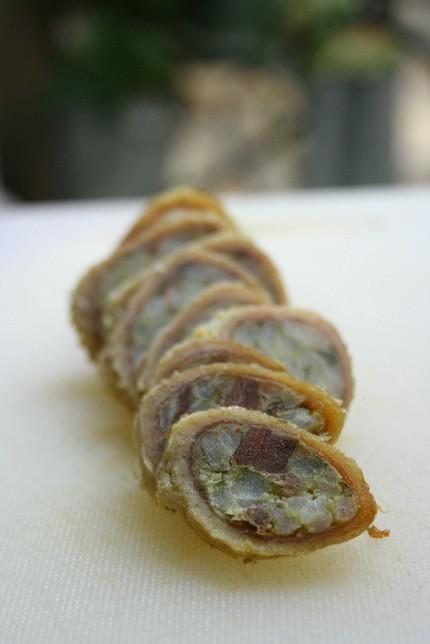 Leftover stuffed duck necks are sliced thin and crispened in a hot pan before the soup is served.
Leftover stuffed duck necks are sliced thin and crispened in a hot pan before the soup is served. 
Crush the szechuan peppercorns and the juniper berries (Note: sublime with the crispy browned duck gratons) with a mortar and pestle and sprinkle over the top of the soup. Serve into hot bowls and enjoy with a local red wine.


The star of the plate today for me was the locally produced sechon.
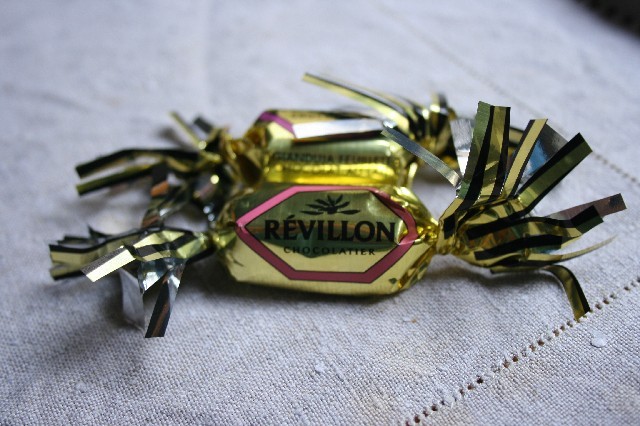
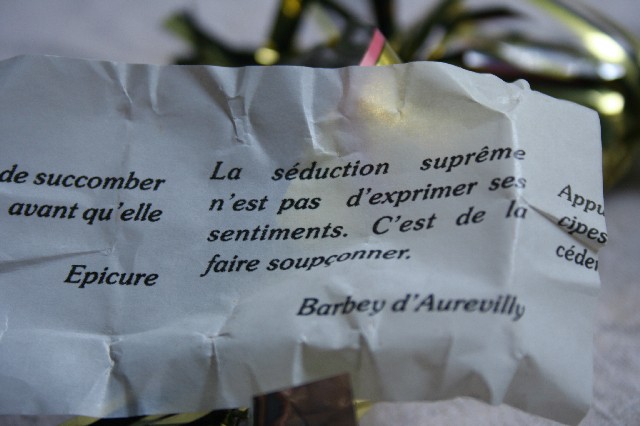
Labels: Autumn, Fall 06, soups, Sunday Dinners
Friday, October 27, 2006
The Duck Neck Dish

This dish is like one big juicy fresh duck crackling cornucopia cradling even more goodness - its soothing decadence transports us and we are shocked back to the present with healthy peppery rocket. It is listed under MUSTS in my kitchen notebook, good in every single way. If I could, I would call this a Lyonnais dish. But it comes from a man in Paris.
When we first moved to France, I was really happy that Aude was passing along monthly issues of the Saveurs magazine to me. The recipes were my first French lessons. I would study them fastidiously with a dictionary. The thing about Saveurs recipes is that they are often from chefs, who like chef M in the cooking class, don't like to really be pinned down too much on ingredients and measurements, and sometimes won't mention a step while they’re doing it. With Saveurs magazine, what we've got to go on is a super styled finished photo of our goal, and sort of a quick rundown on how to execute it.
The recipes are for the people who know what's what in the kitchen, and a lot of slang words for ingredients and measurements are used as well. I remember getting so exasperated with Loïc when I ran across an ingredient I couldn't translate and he said he had absolutely no idea what they were talking about. "These people are crazy" he said. "How am I supposed to know what that is?" he’d say, scratching his head in his scientific way. There was one ingredient standing in the way of me making a certain soup and he wouldn't tell me what it was! I thought he was doing it on purpose and it got me in the fightin’ mood!
Those days are over and over the years the Saveurs magazine and I have come to a kind of detente. I don't ask more of Saveurs than they can give, and they give in their way. I understand. I look for inspiration, and you bet that magazine has lots to give, and with experience in the kitchen and a little bit of ingenuity, I have learned to fill in the blanks. For this recipe, the incredible combination of rocket and crispy browned duck skin is the jewel to be gleaned. In recounting this recipe, I am adding the American measurements and my notes and instructions.
Cous de canard farcis au risotto de roquette – Arugula Risotto Stuffed Duck Necks , a loose adaption from a recipe in edition no. 150 of Saveurs Magazine, by Jean-François Mallet
4 duck necks, whole, not deboned yet
2T. coarse sea salt
2 legs duck confit
1 egg
200g. or about ¾ cup Arborio rice (for risotto)
2 shallots
15 cl or one small glass of white wine, any kind
150 grams or about 1 quart loosely packed fresh leaves of rocket (arugula)
80 grams or about 1/3 cup of grated parmesean cheese
salt & pepper
 About Rocket: aka arugula, or roquette in French, comes in two different forms, wild and cultivated. The wild leaves have more flavor. Either one will do for this recipe and its presentation. Here in Lyon, we have a choice between shipped in from Italy, and locally grown and sold at the market. I have tasted both side by side for this recipe, and will recommend that in addition to paying less for the local, it tastes better too. While the imported version sizzles and pops like a sparkler, reminding us of it's name, the local version's peppery burst explodes on the palate like a healthy burst of sun and warms us from the inside out. Try and get some local rocket for this dish, it takes it to that higher plane. Everyone at the market should have it this time of year.
About Rocket: aka arugula, or roquette in French, comes in two different forms, wild and cultivated. The wild leaves have more flavor. Either one will do for this recipe and its presentation. Here in Lyon, we have a choice between shipped in from Italy, and locally grown and sold at the market. I have tasted both side by side for this recipe, and will recommend that in addition to paying less for the local, it tastes better too. While the imported version sizzles and pops like a sparkler, reminding us of it's name, the local version's peppery burst explodes on the palate like a healthy burst of sun and warms us from the inside out. Try and get some local rocket for this dish, it takes it to that higher plane. Everyone at the market should have it this time of year. 
About confit: This is duck or goose cooked over a period of several hours immersed in its own fat. The result is succulentand moist slow cooked meat, that can be canned and put up for several months. The longer a meat that has been put up by this process is stored, the better it tastes. In fact, canned confit, the kind you can buy in the store, can be excellent indeed – it has had the time to age and do it’s magic in an airtight environment. You can prepare a confit yourself, and store it for occasions such as this. Your product, having been prepared carefully and lovingly at home, will taste even better than excellent indeed. If you do decide to prepare a confit just in time for this recipe, it won’t be as moist and succulent as one which has been in storage for awhile.
- De-bone the duck necks, following my instructions. Liberally sprinkle the outside of the neck skin with salt and place in the refrigerator (can be done up to 48 hours in advance). Remove and discard the esophagus tubes and any glands, and put the neck meat and bones into a stock pot. Cover with water. Bring to a boil and reduce heat, as you would any poultry stock, and let the stock simmer for 1 to 2 hours. An idea for this would be to debone the necks and set the stock to cook in the afternoon, if you plan to serve this dish for dinner, and let it simmer very slowly throughout the afternoon.
- Remove as much duck fat as possible from the duck legs confit, and set the fat aside for later use. Remove and mince the meat from the two legs, and place it in a large mixing bowl where you will mix the stuffing. Add the parmesean.
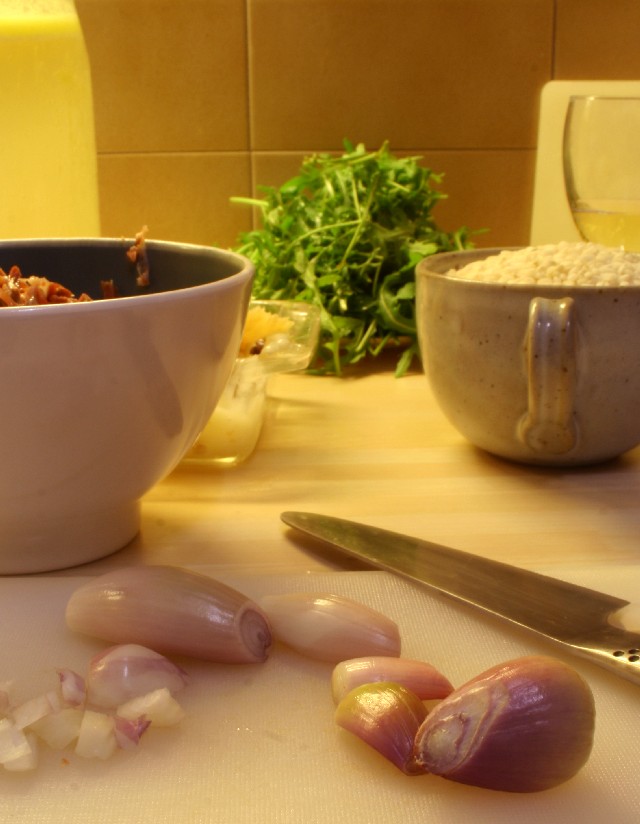
- Prepare the Risotto: Peel and mince the shallots. Melt 1 tablespoon of the fat from the confit and sauté the shallots without browning until they begin to turn translucent. Add the Arborio rice and stir to coat with the duck fat. Once the risotto begins to turn clear, add the white wine and let it absorb into the rice.

Ladle the duck stock directly into the risotto, filling it to just cover the rice, and let it cook without stirring it, absorbing the stock. After adding stock about 4 times, the risotto should be al dente, and you can season it with salt and pepper and remove it from the heat. Let it cool while you prepare the rocket.
- Wash the rocket and chop all but a couple of handfuls of it finely (the recipe says to do this in the mixer, but I don’t recommend it.), and add it to the bowl with the minced confit de canard, and the grated parmesan.

Add the risotto and mix them together, and season. This can be done in advance and refrigerated for later use.
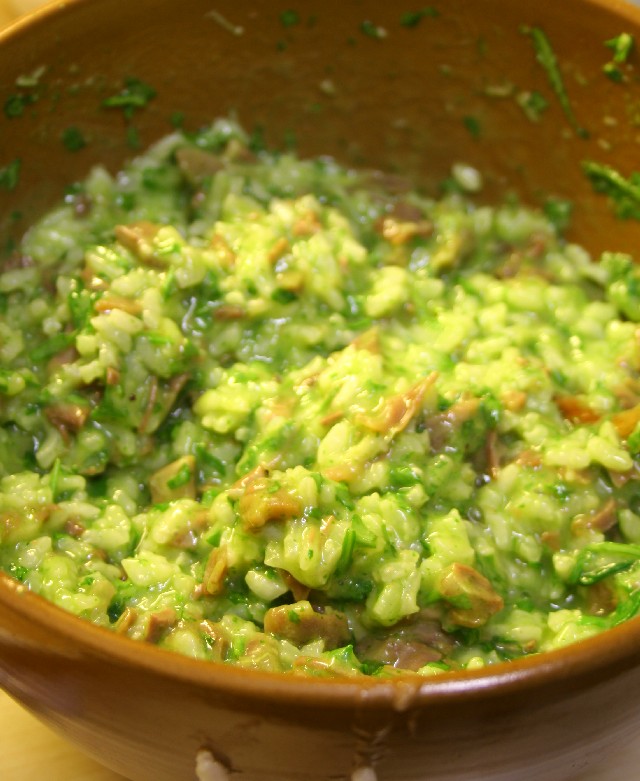
The stuffing actually fills the necks better when it is chilled and somewhat stiff. The recipe says to chill it for 20 minutes, while 10 minutes in the freezer will do. Just before stuffing the necks, add the egg to the stuffing.
- Stuff the necks rather full with the stuffing.

One neck ready to go in the oven.
The question of whether to tie, sew, or otherwise fix the necks closed for cooking comes to mind, and many traditional recipes call for you to fix the pouch closed. My investigations indicate also that if you want the skin to stay taut and thin across the stuffing, you must fix it closed. However, if you simply fold the skin underneath at each end, the neck skin retracts and thickens with cooking, thus squeezing the stuffing out of the end that provides the least resistance. It makes a pretty overflowing cornucopia-like presentation this way, and the neck is juicier in the end. If you prefer to keep the skin thin and crispy, fix it closed, by either sewing it, using a skewer, toothpicks, or string to keep it closed. If you do this, the skin will be thinner. Your choice. Place the stuffed necks in a large ceramic or cast iron dish, giving each room to breathe, room for the heat to get at them from all sides and make them a nice golden brown.
- Salt the outside, and add the remaining duck fat from the confit to the pan, and bake, uncovered, for 30 minutes at 160C/350F. Baste the necks with the liberal amount of fat that is rendered by the neck skin every five minutes during this time. At the end of 30 minutes time, pour off the fat, sprinkle with grated parmesan, and turn up the heat to 200C/450F. Let it continue to brown and crispen on the outside to taste.
- Serve on hot plates with a fresh rocket salad, sprinkled with your choice of vinegar and seasoned with sea salt. There's no need to prepare a vinaigrette to go with the greens, they are just right as is with a little vinegar and salt.

I really loved the combination of the fresh rocket with the rich delicious taste of the duck and risotto. I think they were an excellent combination. Bravo!
Labels: Classic French Recipes, Fall 06
Wednesday, October 25, 2006
How to Bone a Duck Neck
 rue Lanterne, Lyon 1e
rue Lanterne, Lyon 1eBrowsing through the French Saveur recipes, I noticed one that looked like it will be pretty cheap to do. Cous de canard farcis au risotto de roquette. Since cous de canard are about 70 centimes per kilo at the volailler, I knew immediately that this dish would fall in my budget. The first ingredient was:
4 cous de canard desosses (4 deboned duck necks.)
Since I am a complete moron and have absolutely no idea how to bone a duck neck, I went to eGullet to enquire with the experts.
I will prepare this recipe, because it looks like it might be a very good one.
From eGullet and cookbooks on my own shelf, I am getting lots of good info on how to cook a duck neck. I've learned that instead of actually removing the bones from the meat, what they mean by désosser is to remove the skin from the neck and use it as a casing for something braised or confit inside.
 Around the corner from the Dubernet Foie gras shop next to La Bourse, Lyon 2eme
Around the corner from the Dubernet Foie gras shop next to La Bourse, Lyon 2emeActually the French traditionally stuff goose necks with various sausage stuffings and aromatics and slowly cook them immersed in duck fat. The tradition way to cook them is either to put them up for storage like cuisses de canard confit, or bake the resulting inner loaf in brioche to create a kind of pate. But the French are not the only ones to use poultry necks in cooking.
Various traditional Jewish recipes like helzel, where a chicken neck is stuffed with dumpling dough and added to chicken soup. It sounds so delicious!
There are recipes call for a starchy filler of some kind to absorb the flavor and are cooked in less fat, basting instead of immersing. These are sliced and served crispy skin and all. Time to get to work.
How to Bone a Duck Neck
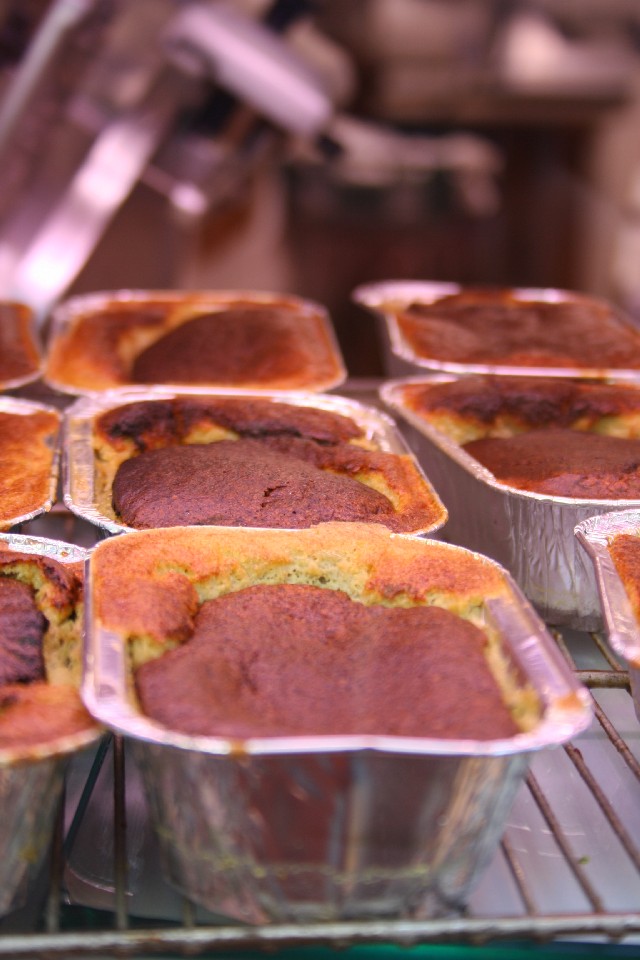 Yummy cakes at Charcuterie Chorliet, rue Plat, Lyon 2eme
Yummy cakes at Charcuterie Chorliet, rue Plat, Lyon 2eme- Don't try and singe any remaining small down from the necks by using a candle. The wax creates black smoke that sticks to the skin and stains it. I lost a duck neck that way, used it as practice. I found that you can pluck the last remaining down with tweezers quite nicely. Do not parboil them. They will shrivel and shrink immediately.
- Begin at the big end. The inside is attached to the skin with filmy clear connective tissue that snips easily with scissors. Snip off any outer bones. On one side, there will be a cluster of fatty material and glands that are attached to the inside of the skin of the neck and are best snipped carefully between that and the skin.
- On the other side, the esophagus tube is attached to the inner muscular shaft and the skin. Clip only the skin side only, leaving the tube attached to the shaft, and fold the skin back all around, little by little, snipping carefully all around, until you have exposed enough of the inner shaft to hold it firmy.
- Take the inner part in one hand, the outer part in the other, and pull firmly but not too forcefully, and release the inner part from the skin. It turns inside out and you just pull it off.
- Turn it back to the right side out and pull off any down or quills that were missed by the volailler. Get them all. Choose carefully when you buy to avoid too much work afterwards. Voila. These are ready.
Labels: Classic French Cooking, Fall 06
Saturday, October 21, 2006
Rable de lapereau farci aux trompettes de la mort et pignons, purée de racine de persil

Yesterday morning I was up early and drinking coffee from a bowl. I was trying not to think about the leftover fondant au chocolat that was loosely covered with foil on the buffet. Tying up a few loose ends. There's that project of the database. There are a whole bunch of contacts that I keep throwing into what has grown to be a huge pile of cards and scraps of paper and things written on corners of things and notes which were meant to be comptes rendus of conversations with people all piled on my desk for the secretary to organize. That would be the inner secretary. What is to become of her? My my.

Managing to get some piles sorted, I didn’t want to stop there. Once I'd got to the pile of cooking schools and places that give cooking classes, I let myself dream for a moment. The grandiose daydream of purchasing a large one-room apartment on the quai above the market which I have been working on for some time was summoned to appear. I’ll turn it into just one big huge fabulous kitchen with cots that fold down from the wall for the serious foodies coming to town who will rough it to make space for what is really important in life. Their goal is learning, cooking and eating in Lyon. I had just gotten to the light fixtures (the ideal fixture would have to be commissioned by a glassblower) suspended above the island in the middle of the voluminous workspace, and reality kicked in. What the hell am I thinking? Where am I going to get the money to do this? Whoa there, Lucy. Take a deep breath. Type your list. Time to take things one step at a time.

How air-headed it was to call the Emile Henry boutique to see if they had a place in this afternoon’s class! I just dialed and asked if they had a space. They're only 5 blocks down the street from me. Too simple. The very nice lady said they were booked through December. Good Lord. I had no idea. "I am so sorry," I responded, ready to leave that idea behind and resume my normal unschooled life. I really can't afford it anyway. I was fully prepared to keep that lunch date with Callan. Then she said: "But… It looks like someone cancelled this morning… "

The kitchen upstairs at the Emile Henry boutique is one room with parquet floors, a marble fireplace, an island in the middle with bar height stools, enough room for 7 students and an instructor to work in a close, well lit, communicative environment. Today our instructor was Chef W. Mahl, who came down from Paris to teach the class. He works at the restaurant l’Orangerie in the Paris 4e, under chef Michel del Burgo, who’s fame comes from his previous position as head chef at Taillevent. There were 7 students and we had him for the afternoon. We were equipped with cutting boards, dishtowels, aprons, a knife, and a small metal bowl each.
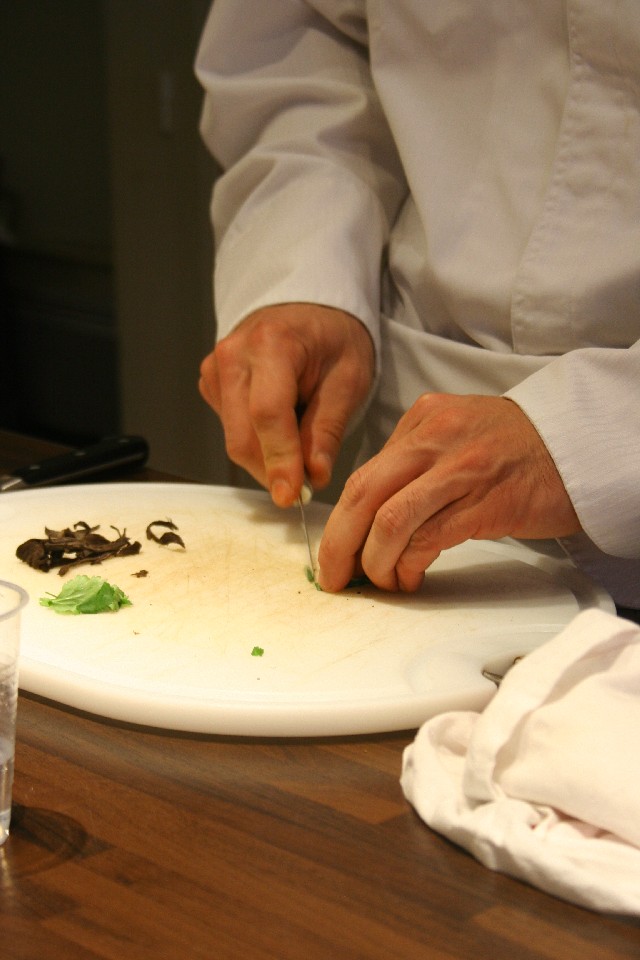
The class was a good combination of demonstration, general discussion of ingredients, and a chance for us to execute the basic elements of the dish he wanted to teach us. I was especially happy with the general cooking discussion going on, the friendly atmosphere, where I learned a few things and had a really good time.

What did I learn? Well, for one thing, I learned the best way to wash trompettes de la mort. These are some pretty sandy dirty escargot laden fungi albeit delicious. I always hesitate to pick them up at the market for fear of the nasty washing up job. Chef Mahl showed us exactly how painless and easy the cleanup can be.

I also learned something about this mushroom and its natural affinity for the flavors of coriander and basil, an interesting and very tasty combination that I have never had the opportunity to enjoy before.

I learned that chef Mahl likes to include an aromatic bouquet when he boils potatoes, and his method of seasoning. The bouquet idea and his idea of braising potatoes in a casserole in the oven instead of boiling on the stove top is also something I plan to try the next time I am making a puree de pommes de terre. I learned by watching and doing.


The recipe provided by Chef Mahl did not contain any proportions, nor did it include all of the ingredients we used, because his deciding to focus on the mushrooms, in high season at the moment, at the last minute.

He stressed that this method of rolling a stuffing in this way and then roasting it this way can be used with any meat, poultry, or fish. Rabbit was what we cooked in the class, but the possibilities are endless.
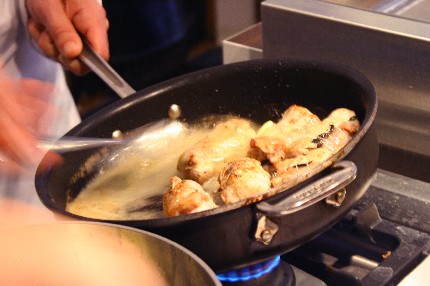 Fish, Chicken, Rabbit, game, beef, pork, etc. are all possibilities, as are any combination of herbs.
Fish, Chicken, Rabbit, game, beef, pork, etc. are all possibilities, as are any combination of herbs.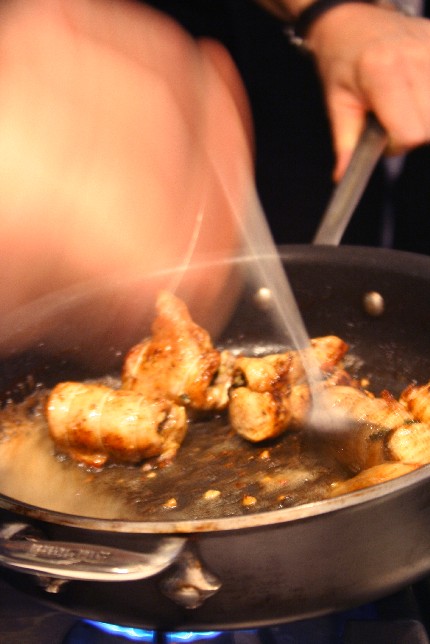
This is the kind of advice I like. It is all about ideas, and flexibility, and having fun.

We each prepared a very small version of the dish he proposed, just enough to get us ready to take it one step further.

Oh, and we got a free gratin dish!
Today I shopped at St. Antoine and decided to prepare this dish in my own kitchen while its fresh in my mind. I was thinking that a puree of something a little bit different might really make this special. I saw some parsley roots from the producers that sell the flower bulbs in the fall. What a great idea! The man cut off a piece of the root for me to taste. Slightly peppery, no hint of sweetness. What a great idea for a puree to accompany a rabbit dish!
Rable de lapereau farci aux trompettes de la mort et pignons, purée de racine de persil
for 4 people :
4 young rabbit saddles or a combination of rabbit saddles and chicken breasts
about 100 grams or 1/2 cup pine nuts
1/2 a bunch of coriander
1/2 a bunch of basil
200 grams or 1/3 pound black trumpet mushrooms
200 grams or 1 1/2 sticks butter
4T. butter
salt and pepper
--------------
500 grams of parsley root (not parsnips!)
1/2 cup basic mixed poultry stock (duck, chicken, guinea hen)
3 Tablespoons creme fraiche or heavy whipping cream
Note: This is a seasonal recipe. As the black trumpet mushrooms come into season, they fall just on the cusp of the time when you can find local fresh basil. Basil is on the way out, trumpets are in, and coriander is fresh and plentiful at the moment. The window is short, but when really fresh, the combination is a powerful one. The time is now.
About black trumpet mushrooms:
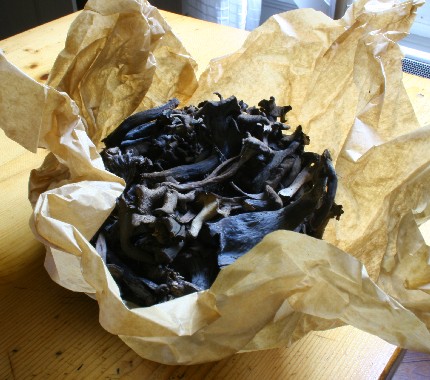

Choose dry firm mushrooms that are in tact if possible. Avoid any that look slimy or are wet, because they risk being past their prime.
About parsley root:

Parsley roots are NOT parsnips. They are the comestible root of parsley. They have a slight peppery savory flavor that does not resemble the sweet flavor of parsnips at all. If you do not have parsley root, prepare your favorite mashed potato dish!
- Clean your black trumpet mushrooms.
 Remove the muddy stump from the mushrooms that have them.
Remove the muddy stump from the mushrooms that have them.
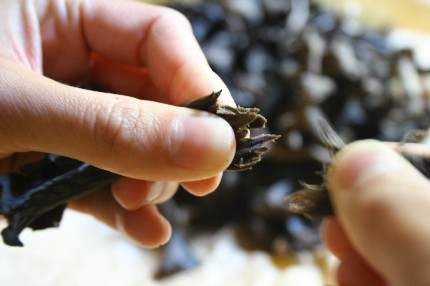
Tear them into thin strips, removing any visible large debris and insects or snails.


Immerse them in water for just a few seconds agitating the bath quickly to allow the sediment and sand to come off of the mushrooms.
 A quick bath - do not soak them.
A quick bath - do not soak them.Repeat this process up to 4 times, until there is not more sediment in the water, and dry them promptly in a clean dish towel. Do not let the mushrooms soak. This process should be a quick one.
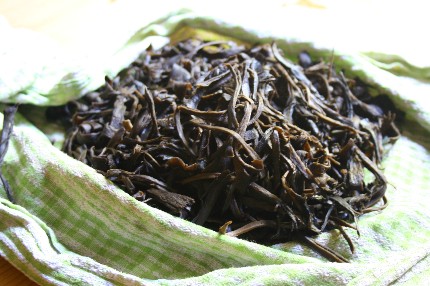
Nice and dry after 4 quick rinses.
- Clean and cut the herbs.


Wash them, dry them, remove the leaves from the coriander and basil, roll, and cut into a fine chiffonade.
- Remove the fat and any organs from the rabbit saddle.

- Debone the rabbit saddle by cutting down along side of the spine, resulting in two pieces that include the thick back muscle and the thin side flaps. To try and make the flap, which is diagaonally shaped into a rectangle, slice carefully into the saddle meat to roll it out slightly. It should remain in one piece.
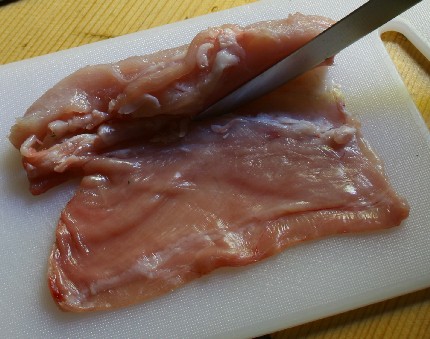
If you are using chicken, flatten the chicken breast by cutting into the large edge from the middle and folding out as if opening a book, then in the opposite direction to make one large flat fillet.
- Chop the pine nuts roughly and set aside.
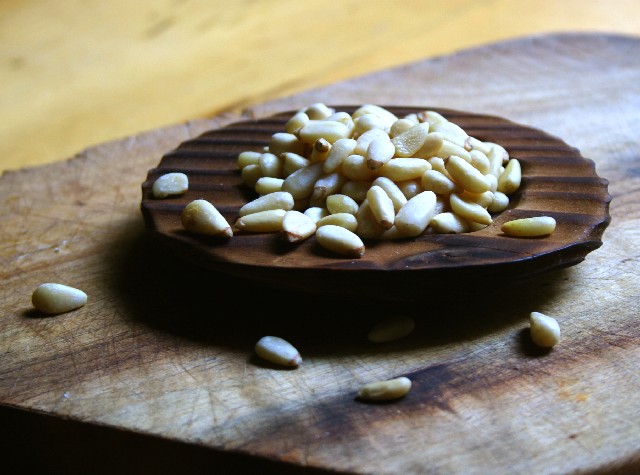
- Heat 1 tablsepoons olive oil with 2 tablespoons of butter in a saute pan until hot and add the mushrooms. Season with salt to allow them to selease their juice. Add the pine nuts when the juice begins to reduce. When the saute begins to release a toasted nutty aroma, add the herbs, and toss for another minute or two and remove from heat.
- Spread the mushroom mixture onto the thin flap of the rabbit or onto 3/4 of the flattened chicken breast, and roll. Fix the stuffed saddle with twine.

- Peel the parsley root, cut it into small pieces.
- Heat the remaining butter and oil in a large saute pan, and when sizzling hot, add the stuffed rabbit and/or chicken rolls, turning every few minutes to brown on each side over high heat, and then lowering the heat somewhat to keep the oils from burning.
- Spoon 2 tablespoons of the meat rolls cooking fat into a seperate saucepan, and add the parsley root over high heat. Toss and stir to keep it from burning but allow it to brown only slightly. Add the mixed poultry stock and cover tightly, and set the timer for 15 minutes.
- Continue to saute the stuffed rabbit and/or chicken, tilting the pan and spooning the cooking juices over the meat to keep it from drying out. Cook for another 5-10 minutes, and test the poultry either with a probe thermometer or cut to visually see that the meat is done.
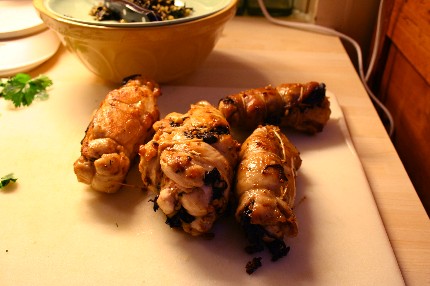
- Mash the parsley root with a fork, add the creme fraiche, refresh with butter if desired, and season.
- Serve on warm plates: remove the twine, and cut off the ends of the stuffed meat rolls to provide a blunt end to stand up on. Cut each roll in half diagonally and arrange with the mashed parsley root.

Chicken on the right, rabbit on the left. The rabbit has a more delicate flavor and balances the flavor from the mushrooms, while the chicken seems to bring out the flavor of the herbs more. We enjoyed this with a light young Saumur Champigny, Domaine des Varinelles. If you are choosing an American wine, look for a Cabernet Franc. A mes amis français: vos commentaires en français sont bienvenus!
Labels: Autumn, Classic French Cooking, Fall 06, Lyon Cooking Classes










